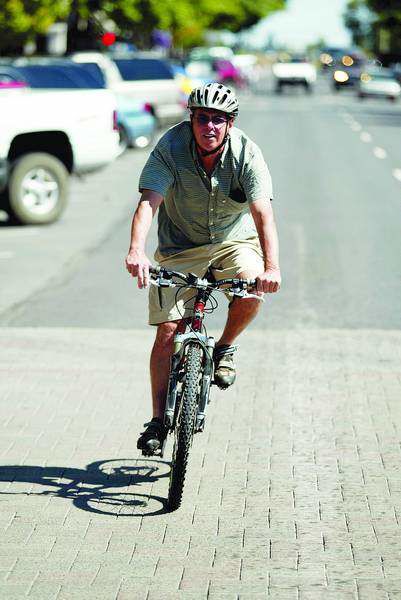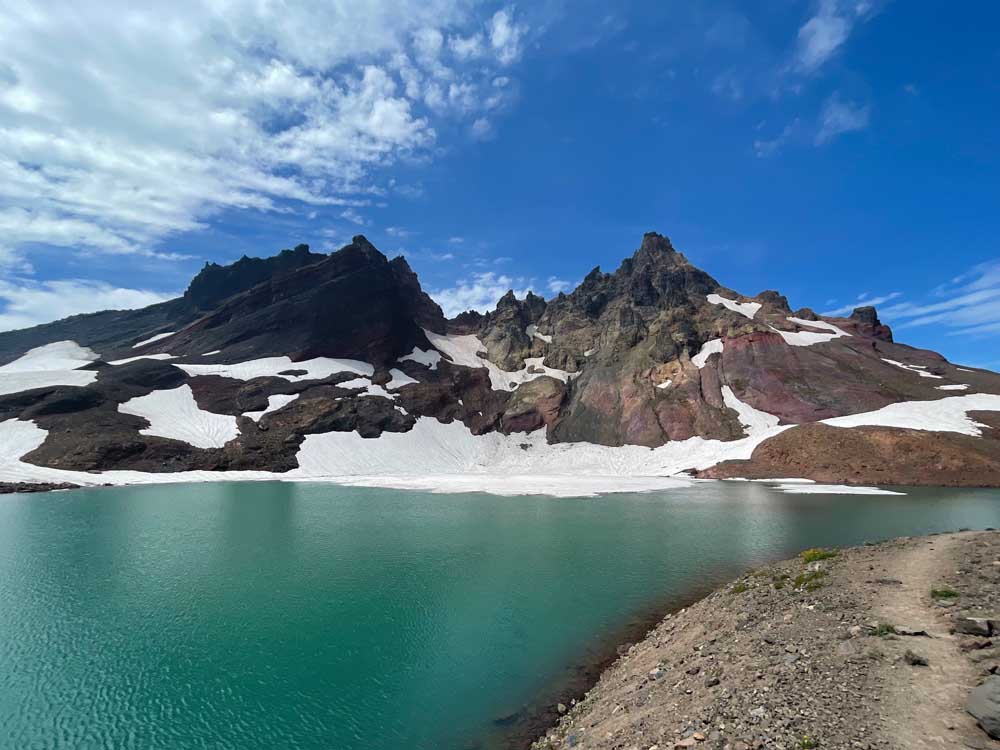Rules of the road
Published 5:00 am Wednesday, August 16, 2006

- Dave Magness wears a bike helmet, although it is not required by law for cyclists older than 16, as he cruises down Skyliner Road in Bend on Tuesday evening.
Bend’s reputation as a biking mecca isn’t limited to the seemingly unending stretches of sweet single-track running through national forestlands.
City streets and highways are decked out with bike lanes that just beg cyclists to get on the saddle and ride.
Trending
Making the city bike-friendly is a goal that planners have kept in mind when revamping downtown streets and main arteries, said Deborah Hogan, traffic safety coordinator for the city’s Department of Public Works.
The efforts have paid off, landing Bend a spot on the nonprofit League of American Bicyclists’ list of 49 bicycle-friendly communities in the U.S. And the long-term plan is to continue encouraging cyclists to get the rubber on the road. Adding bike lanes where they didn’t exist before, like along the Newport Avenue Bridge, will mean more people can get around on two wheels, Hogan said.
The increased number of riders – particularly in the summer months – means bikers, as well as motorists, should know the rules of the ride.
Roundabouts
”The biggest question we get is ‘What do I do at a roundabout?’” said Steve Esselstyn, community liaison for the Bend Police Department.
The answer: It depends.
Trending
”If they are under 12 or 13 or not an experienced rider, then they should use the crosswalk,” Esselstyn said. ”Experienced riders should take the lane because (bikes) are considered a vehicle under Oregon law.”
Riders should resist the urge to stay to the right in a roundabout, Esselstyn said, because that dramatically increases the chance of a collision with an exiting car. Instead, bikers who take the lane should stay in the middle while riding through a roundabout.
”Most car drivers, if they are not bicyclists themselves, are totally unaware that the biker is supposed to take that lane,” Esselstyn said.
And plan ahead, said Kim Curley, of Commute Options for Central Oregon, a local bicycle advocacy group.
”You need to take the lane 50 or 75 feet before the roundabout to make sure you don’t get squeezed out,” she said. ”Signal right upon entry, and then don’t signal again until you’re exiting.”
Cyclists should let drivers know when they plan to exit by extending the right arm before leaving the traffic circle.
”When you leave the roundabout, the bike lane is going to reappear, so you can just scooch back over,” Curley said.
Riders who choose the crosswalk option face a twist under Oregon law, which treats all nonmotorized crosswalk users as pedestrians, according to Portland attorney Ray Thomas, author of ”Pedal Power, A Legal Guide for Oregon Bicyclists.”
That means bikers must yield the right of way in a crosswalk to walkers and, by law, go no faster than ”walking speed.”
Rolling with tons of metal
Pulling up next to a line of stopped cars can be intimidating for riders who don’t know the rules of the road, Esselstyn said.
The likelihood that a car will cross a cyclist’s path goes way up at an intersection, he said, but bikers in the know can avoid potential mishaps.
If a cyclist pulls up to an intersection at the same time and in the same lane as a car, the biker should yield the right of way to that car, Esselstyn said.
Otherwise, bikers need to yield right of way at intersections in the same way a car would, Esselstyn said.
”But it’s generally easier for the bicyclist to yield the right of way, irrespective,” he said. ”And in a vehicle-versus-bike situation, the car is going to win every time, so give those cars a little slack and realize they will be out of your way in a moment.”
And cyclists should always ride with the flow of traffic, he said, because most drivers don’t expect a bike to be headed in their direction.
”Remember that you won’t make a good hood ornament,” Esselstyn said.
Keeping an eye out for the little guy
On the flip side of the coin, Curley said, drivers should know to approach bikers with the same defensive driving techniques they would use with another car.
”If they are on a busy street and there is a bike, just follow the rules of the road that you know, because bikes must follow the same rules,” she said.
In most cases, Oregon drivers who pull into bike lanes or park their cars there are breaking the law.
Notable exceptions include a driver making a turn or entering or exiting an alley or driveway.
And opening a car door into a bike lane without checking for cyclists first is a definite no-no.
In the event of a run-in between a cyclist and a car door, Oregon law is on the side of the bicycle rider, according to Thomas’ book.
In Oregon, opening a car door when it is unsafe or leaving the door open longer than necessary to load or unload passengers is punishable by a $90 fine.
But that could be a drop in the bucket when compared with a potential court battle over an injured rider’s medical bills.
”Each side needs to realize that they need to follow the rules of the road,” Esselstyn said. ”If people drive safely and bike safely, there will be a lot less conflict.”
Safety first
Cyclists spinning their wheels along Oregon roadways must have a ”properly equipped” bike.
Outfitters recommend carrying a tool kit, bike lock, spare inner tubes and a tire pump.
And the law requires riders to have lights, both front and rear, under some conditions.
Cyclists on the road during ”limited visibility conditions” must have a white light in front that is visible from a distance of at least 500 feet from the front of the bicycle.
The law also requires a red reflector or light in the rear that is visible from 600 feet.
Commute Options of Central Oregon gives out free red safety lights that flash, Curley said.
”Motorists are busy driving and not looking for you, so it’s your job to be noticeable,” she said.
Anyone who needs a red light can call Commute Options at 330-2647. Curley also recommended wearing bright and reflective clothing.
Packets of reflective stickers from the Oregon Department of Transportation – perfect for getting drivers’ attention – are also available through Commute Options, Curley said.
Bike safety advocates say helmets are essential equipment for all riders, but only cyclists ages 16 and younger are required by law to wear them.
”But parents usually set the standard on that,” Esselstyn said. ”They figure ‘Well my mom doesn’t wear a helmet, so why should I have to?’ ”
He said police don’t often hand out tickets for failure to wear a helmet, but the fine is $25.
Even in seemingly safe situations, riders should strap on a lid on their noggin, Curley said.
Riders heading out for a latte or some window-shopping should remember that accidents can happen – even on a mellow ride, Curley said.
”We have a lot of people riding around downtown not using a helmet,” she said. ”I know you’re not planning on crashing your bike, but you never know what is going to happen. It’s just like putting on your seat belt before you leave. You gotta do it.”
Lost and found
Police take in hundreds of abandoned, stolen and lost bikes each year, said Paul Ruder, evidence technician for the Bend Police Department.
But only about one in 20 gets back to its rightful owner.
A city ordinance requiring riders to license their bikes goes largely unheeded, Ruder said, leaving officials with few resources to help track bike owners down.
The best bet is to match a bicycle’s serial number with a report stating the bike has been lost or stolen, he said.
”The license is just a sticker that can be scraped off,” he said. ”If they record their serial number and report it when (the bike) is stolen, then the serial number goes into the computer as a stolen bike.”
Otherwise, Ruder can only wait and hope that someone calls in a report.
He said the department takes in some bikes worth thousands of dollars that end up getting auctioned off after 60 days. But most bring in only a few dollars for the department.
”Probably five or six bikes bring in $100, and some end up getting destroyed because they don’t have any value,” Ruder said.
He said not being able to get bikes back to their owners is as frustrating as watching them pile up in the department’s storage locker.
Free helmets
Free bike helmets are available for children in Deschutes County. Vouchers for the helmets are available at the following locations:
Bend Police Department: 555 N.E. 15th Street; 322-2960
Deschutes County Sheriff’s Office: 63333 W. U.S. Highway 20, in Bend; 388-6655
Bend Fire Department: 1212 S.W. Simpson Ave; 322-6300








